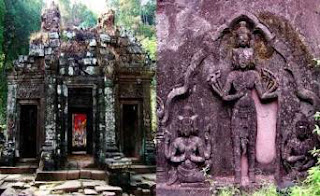The Hindu temple is one of the living example of strangest and most amazing architectural artefacts that still mysteriously attracts people even in today’s modern era. There is an unimaginable intelligence behind ancient Hindu temple art style as well as a subtle universal philosophy of life. The Hindu temple is a scientific and psychological representation of a divine body which is an intellectual system intended to bind together human beings and cosmic energies. However, many may think that such ancient Hindu temples exist only in India and Nepal. But no, there are many amazing ancient Hindu temples outside India and Nepal that still fascinate people today. Vat Phou temple is one such mysterious ancient Hindu temple. Which is located 2,453 km away from India, in a country called Laos.
 |
| Vat Phou Temple |
Vat Phou is ruined temple complex located in Champanak, across an area of 6 km, in the south region of in Laos. It is known from the rock inscriptions found in the precincts of this ancient temple that the construction of this sanctuary was completed in the 5th century, during the same time as the foundation of the temple town. According to some experts some portions of this sanctuary was added and reconstructed between 11th to 12th century.
Past Background
The first temple construction dates back to the 5th century, probably even during the Khmer Empire, and are located in the already famous Ankor Wat temple complex. Other temples were added during the 11th and 12th centuries. The region was considered sacred by the ancient Hindus that were settled in this area, still today a strong Hindu influence, is visible, as is also the case in Cambodia, Malaysia, Myanmar, Indonesia, Thailand and South Vietnam, when the Hindus were in these areas. This fertile area with its natural beauty, is great for building Hindu temples. The temples are also facing east, as do most Hindu Temples.
These temples having been built upwards on the sides of the hill, there are stone steps that lead us to these beautiful ruins. That take us back into the time, "when the world was Hindu." At the top of the hill is the main temple which is dedicated to Lord Shiva. Out in the back, there is a small statue of Nandi the bull. The passage of time can be seen on the crooked roots of the trees, that are pushing up and tilting sideways the slabs that make the steps up to some of the temples.
Temple Science
Like many other Khmer temples, Vat Phou is aligned eastward, while the axis faces eight degrees south of due east, being mainly determined by mountain and river direction. The east side has three gateways: from the south to the north, their sculptures depict Krishna beating the nāga Kaliya; Indra riding Airavata; and Vishnu riding Garuda. The east wall shows dvarapalas and devatas.
The lush vegetation, and abundant water, make it a suitable area for a Hindu temple. The mountain Pho Kao is on the background, some consider this mountain has been was considered sacred, by the Khmer people, because of a natural formation similar to a Shivlinga. There is a lake nearby, not far from the Mekong River, which can be seen from this hill, and other amazing views. The complex also has clear fresh water flowing from a waterfall, which is used to pour that fresh, cold water onto the Shivalinga. Comparing this mountain with the Himalayas, the locals devotees consider this mountain to be the house of Mahadev and they consider the water of this river as sacred as the water of Ganges.
This temple complex is surrounded by rocks, and boulders, some with fine carvings on them, done by skilled Indian craftsmen, with fine carvings. One of those boulders, has been "turned" and engraved as an elephant, the carver must have had a good artistic imagination, and by taking advantage of the natural shape of this boulder to transform this boulder into an elephant.
Additional Information
Later the temples became a Theraveda Buddhist Temples. There is a big Buddha statue, at the entrance of a temple, but the lintel above shows carvings relating to Hindu deities. Sadly not much has been done to repair or to preserve these temples, unfortunately there had been some vandalism damage too, one does not even have a roof. There are other temples in ruins, but still standing. Many tourists, especially amateur and professional come to this hill to take photos of this hill, and the ruins, really a beautiful place to take photographs. This complex is now on the list of UNESCO World Heritage Sites.
A project to restore the temple was launched by the Archaeological Survey of India (ASI) in 2009, and a team led by R. S. Jamwal arrived there and carried out the restoration work.
No comments:
Post a Comment
Please do not enter any spam link in the comment box. Thanks for reading our articles.